Salzachöfen
Salzachklamm - Erlebnisschlucht Salzachöfen
Useful Information

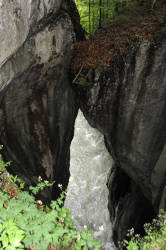
| Location: |
Pass Lueg.
From Salzburg freeway A10 south, exit Golling, through Golling, turn right on highway B159, when the valley becomes narrow turn left on Pass Lueg road. Parking lot at the road. (47.576376, 13.191950) |
| Open: |
MAY to OCT daily 9-18. Erlebnisschlucht: MAY to OCT daily 10, 14, after appointment only. [2021] |
| Fee: |
Adults EUR 3, Children (6-14) EUR 1,50, Children (0-5) free, Family (2+*) EUR 7.20. Groups (15+): Adults EUR 2.40, Children (6-16) EUR 1.20. Erlebnisschlucht: Adults EUR 34, Locals EUR 31, Children (8-13) EUR 19, Children (5-7) EUR 14, Children (0-4) free. [2021] |
| Classification: |
 Gorge Gorge
|
| Light: | bring torch for Dom |
| Dimension: | L=1500 m, VR=22 m. |
| Guided tours: |
self guided, D=60 min. Erlebnisschlucht: D=2.5 h. |
| Photography: | allowed |
| Accessibility: | no |
| Bibliography: | |
| Address: |
TVB Golling, Salzachöfen, 5440 Golling, Tel. +43-6244-4356.
E-mail: Erlebnisschlucht Salzachöfen, Pass-Lueg-Hohe, Salzachtal Bundesstraße 82, 5440 Golling an der Salzach, Tel: +43-6991-1437302, Tel: +43-6602-603820. E-mail: Hotel Pass Lueg, Pass Lueg Straße 82, 5440 Golling an der Salzach, Tel: +43-6244-4280. E-mail: |
| As far as we know this information was accurate when it was published (see years in brackets), but may have changed since then. Please check rates and details directly with the companies in question if you need more recent info. |
|
History
| 06-SEP-1931 | Adolf Anderle’s descent of Salzachöfen is considered the birth of whitewater kayaking. |
| 1982 | declared a Naturdenkmal (Natural Monument). |
Description
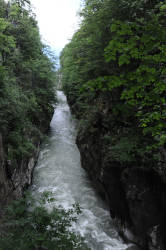
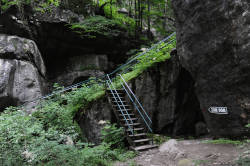
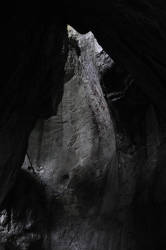
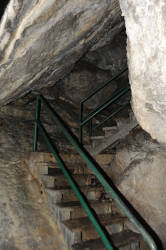
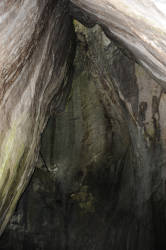

The Salzach river is the famous river flowing through Salzburg. It comes from the Alps in the south, and when you follow the river upstream you finally reach the town Golling an der Salzach. Here the wide valley with its flat floor ends abruptly at a steep limestone mountain ridge. The freeway crosses the barrier through tunnels, even the state highway along the river has a short tunnel. Leave the freeway at Golling and follow the highway, before the tunnel follow the sign Pass Lueg. It’s called a pass, but in a country with 2000 m high passes, it is rather unimposing. On this old road are the entrance to the Salzach gorge and a hotel named after the pass.
The Salzachöfen is a gorge formed by the Salzach cutting through this limestone massive.
In Austria narrow gorges have their own name, which is Klamm, and this gorge is also known as Salzachklamm.
The name Öfen is actually plural, Öfen translates ovens, and what they mean are the
 potholes
and other erosional forms.
So it actually means the rapids and waterfalls of the river, not the narrowness of the gorge.
It is used for rivers with rapids even if there is no gorge.
potholes
and other erosional forms.
So it actually means the rapids and waterfalls of the river, not the narrowness of the gorge.
It is used for rivers with rapids even if there is no gorge.
The wide valley is a typical glacial valley, formed by the glaciers of the last cold age. After the glaciers were gone, there was a sort of step, the lower part was deepened by the glacier, the upper was not. The river was forming a waterfall and because of the steep gradient and the resulting high energy it cut rather quickly into the rock and formed the gorge. It also cut the mountain ridge in two parts which have different names, on one side it is called the Hagengebirge (Hagen Mountains) and on the oter side the Tennengebirge (Tennen Mountains). The terms Pass Lueg and Salzachöfen are both sometimes used to refer to the whole canyon.
The Salzachöfen has a completely different character than all other gorges in the Alps. The main reason is that the Salzach river is much bigger than the small brooks which formed the other gorges. Also the river has cut so deep, it actually has only a slight slope in the gorge. And the most extraordinary thing is that a long section is absolutely straight, most likely it was formed along a crack in the rocks caused by the folding of the rocks during the orogeny. Nevertheless, the high amount of water and huge blocks in the river bed make the river quite dangerous. And during times of high water the level may rise substantially.
The gorge is quite popular among whitewater kayakers. A plate in the gorge from the Akademischer Kayakclub (academic kayak club) commemorates the first kayak ride through the Salzachöfen by Adolf Anderle. This tour is considered the birth of whitewater kayaking. He was actually an extreme sport fan and did a lot of dangerous stunts. He survived the kayak ride unharmed, but half a year later he died in a skiing accident.
After entering at the ticket office, there is a short hike to the gorge. A trail through the forest leads to a shelter, which is famous for its archaeological excavations. The oldest remains are 10,000 BC from the late Old Stone Age, and represent the first time this area was ice free. Quite exceptional are small tools made of rock crystal. Other findings are from the Middle Stone Age (10,000 to 5,000 BC) and Late Stone Age (5,000 to 2,000 BC). Also remains from the Bronze Age (2,000 to 750 BC) were found. Pass Lueg was used to cross the Alps for the last 12,000 years, at least it was the access to the valley behind after it had become ice free. The hunters and gatherers used this shelter on hunting trips and for fishing. At least in the first millennia the level of the river was right below the cave. Discoveries in other places of Pass Lueg from Roman and Medieval times make clear that this pass was an important passage for the last 12,000 years.
Further down the hill, the rim of the gorge is reached. Several long staircases lead down to the rim of the gorge and then along the gorge with various outlooks. There is even a sort of metal halfbridge which serves as an outlook with a great view down into a huge daylight shaft. At one point the vertical wall closes, and the river twists through a much narrower section. The trail was built as an elevated trail through a landslide area. Huge blocks form 10 m to 20 m high blocks with crevices. A staircase leads into a natural amphitheatre with side branches into its huge cavernous nooks and crannies.
From the amphitheatre the main sight of the gorge is reached, called Dom (the dome). This is the place where the landslide reached the gorge.Debris and smaller rock were transported away by the water, but some massive blocks are stuck in the gorge. The form a huge tectonic cave or boulder cave, with the river at the bottom. The shape is quite irregular and actually resembles a set of domes. A torch is recommended but not necessary.
Unlike other gorges in the Alps, there is no trail through the gorge. The forst has walking trails along the gorge, but there is only one trail going down to the dome and visitors have to return on the same trail. We recommend a good cup of coffee and probably an Apfelstrudel afterwards in the beergarden of the Hotel Pass Lueg at the entrance.
The gorge is home to an event company called Erlebnisschlucht Salzachöfen, which offers various activities around the gorge. They offer an 800m long zip line, via ferrata, boat rides through the gorge, incentives for companies, and various educative tours for schools. The shelter with its prehistoric and Bronze Age remains is the center of special historic tours for schools. The sportive tours have fancy names like Skyfall, Waterdrop, Flying Pirates, Fly2fly, or Fly2jump. There are also joint packages with the castle Hohenwerfen or the salt mine Salzwelten Hallein.
 Search DuckDuckGo for "Salzachöfen"
Search DuckDuckGo for "Salzachöfen" Google Earth Placemark
Google Earth Placemark Salzachöfen - Wikipedia (visited: 01-AUG-2021)
Salzachöfen - Wikipedia (visited: 01-AUG-2021) Salzachklamm am Pass Lueg, official website (visited: 01-AUG-2021)
Salzachklamm am Pass Lueg, official website (visited: 01-AUG-2021) Index
Index Topics
Topics Hierarchical
Hierarchical Countries
Countries Maps
Maps